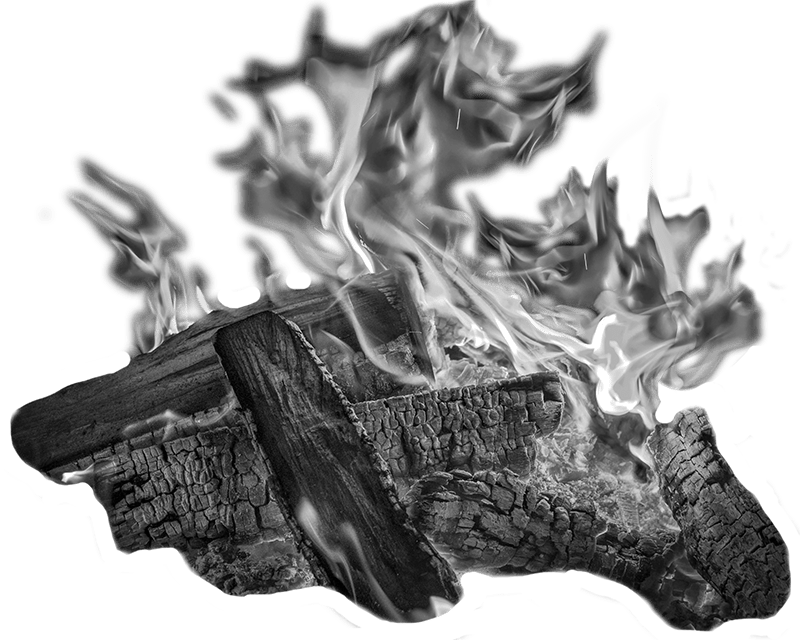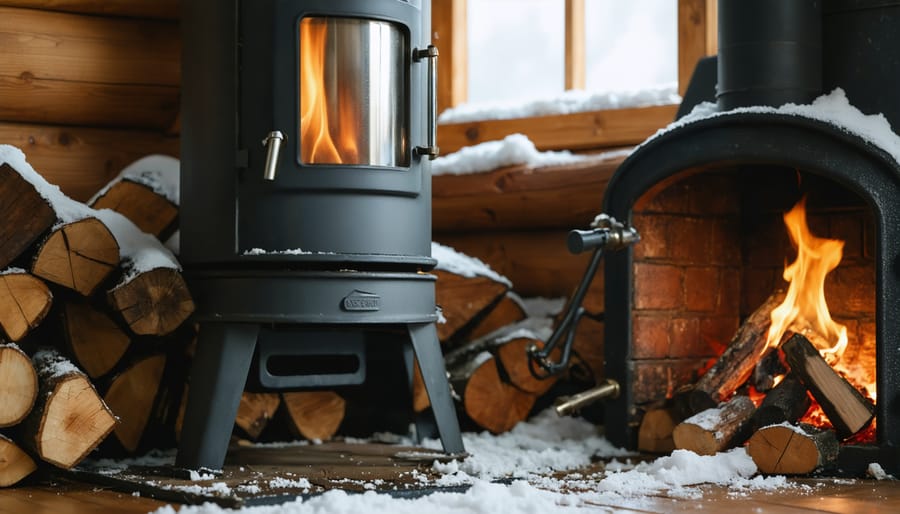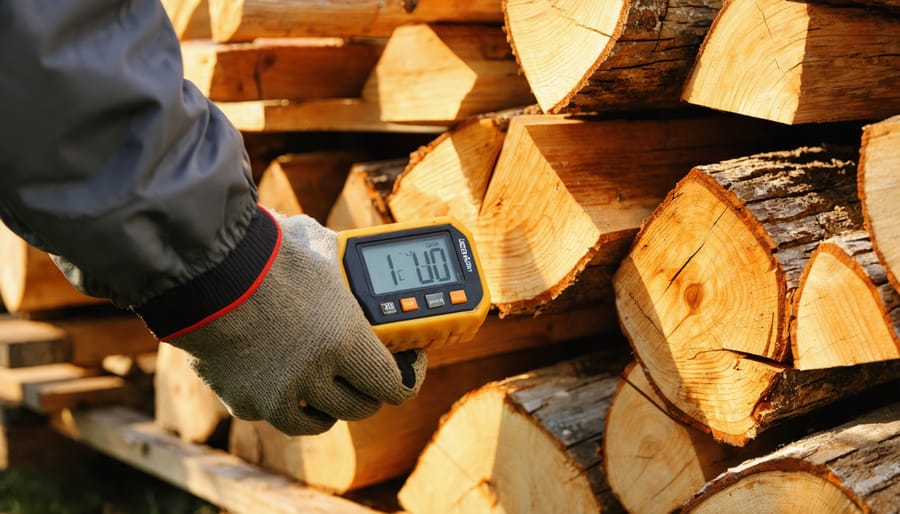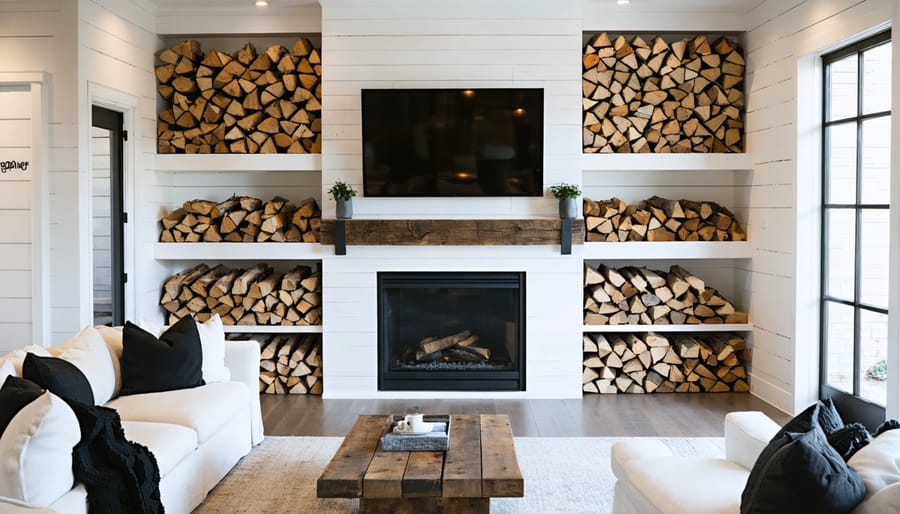Upgrade to high-grade stainless steel piping to eliminate corrosion issues and extend your system’s lifespan by decades—cheap galvanized pipes may save money initially but create dangerous creosote buildup and costly replacements within years. Match your 8-inch wood stove pipe diameter precisely to your stove’s collar opening, as even slight mismatches force inefficient airflow patterns that waste fuel and reduce heat output by up to 30 percent. Install double-wall insulated sections through any exterior runs or unheated spaces to maintain consistent flue temperatures above 250°F, preventing the condensation that forms stubborn creosote deposits and creates chimney fire hazards.
Your 8-inch system represents the sweet spot for medium to large wood stoves, providing enough draft capacity to burn efficiently while maintaining manageable installation requirements. The wider diameter accommodates greater heat output without creating back-drafting problems common in undersized systems, making it ideal for heating spaces between 1,500 and 3,000 square feet. Understanding how proper pipe selection, strategic installation angles, and quality connections work together transforms an adequate heating system into an eco-friendly powerhouse that cuts your heating bills while creating the cozy ambiance only real wood heat delivers. Whether you’re troubleshooting performance issues with an existing setup or planning a new installation, mastering these eight-inch pipe fundamentals ensures your wood stove operates at peak efficiency throughout countless winters ahead.
The Science Behind 8-Inch Stove Pipe Performance
How Pipe Diameter Impacts Draft Strength
Think of your wood stove pipe as the lungs of your heating system. The diameter directly determines how well smoke and gases can escape, creating the draft that keeps your fire burning efficiently and your home safely heated.
An 8-inch pipe creates a specific draft capacity based on its cross-sectional area. When properly matched to your stove, it allows exhaust gases to rise at the ideal speed, maintaining optimal combustion temperatures while preventing smoke from backing up into your living space. This size typically suits medium to larger wood stoves, generally those with outputs between 60,000 and 100,000 BTUs.
Using an 8-inch pipe on a smaller stove creates an oversized situation. The excessive space means gases cool too quickly as they rise, weakening draft strength and potentially causing creosote buildup. Conversely, if your stove’s manufacturer specifies an 8-inch outlet but you install a smaller pipe, you’re restricting airflow. This undersized scenario forces your stove to work harder, reduces efficiency, and creates dangerous backdraft conditions.
The sweet spot happens when your pipe diameter matches your stove’s specifications exactly. Check your owner’s manual or the manufacturer’s label on your unit. This isn’t an area for guesswork, as proper sizing directly impacts both your heating performance and household safety while maximizing the eco-friendly benefits of burning wood efficiently.
Heat Loss Through Your Stovepipe
Understanding heat loss through your stovepipe is essential for maximizing your wood stove’s efficiency. Typically, a significant portion of heat—sometimes 20-30%—escapes through the chimney rather than warming your living space. With an 8-inch pipe, this challenge becomes more pronounced simply because of the larger diameter. More surface area means more opportunity for heat to travel up and out instead of radiating into your home.
However, this larger size also presents unique opportunities for optimization. The increased airflow capacity means your stove can operate more efficiently when properly configured, creating better combustion and cleaner burns. You can enhance heat retention by installing a wood stove fan near your stove, which helps circulate warm air before it rises into the pipe. Additionally, ensuring proper insulation around your pipe sections, especially where they pass through walls or ceilings, prevents unnecessary heat escape. The key is finding the sweet spot where your stove draws adequately while capturing maximum warmth for your home—a balance that makes choosing quality components and proper installation crucial for your heating success and fuel savings.
Choosing the Right 8-Inch Pipe Material for Maximum Efficiency
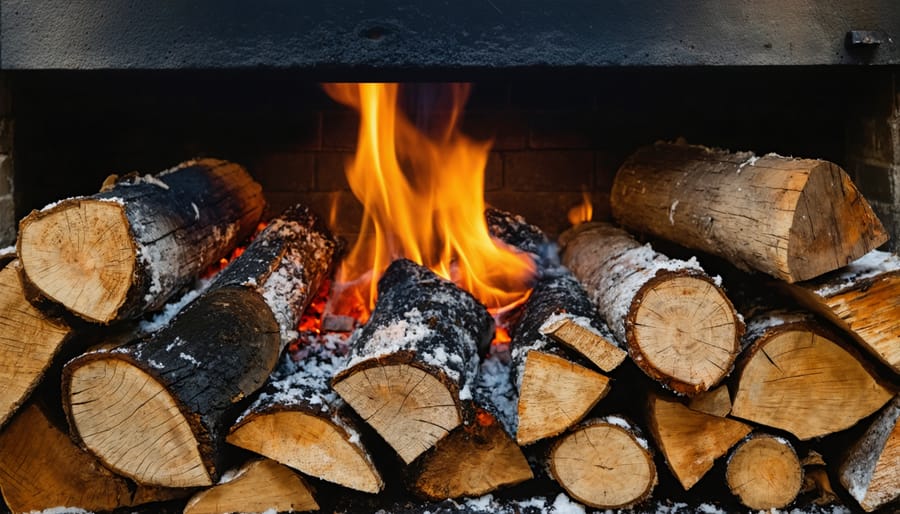
Single-Wall vs. Double-Wall: The Efficiency Trade-Off
Choosing between single-wall and double-wall pipe for your 8-inch wood stove system involves balancing performance, safety, and your home’s specific needs.
Single-wall pipe offers a budget-friendly option that radiates more heat directly into your living space. This radiant warmth can feel wonderfully cozy on cold winter evenings, effectively heating the room where your stove pipe passes through. However, single-wall pipe requires larger safety clearances from combustible materials—typically 18 inches or more—which can limit placement options in smaller spaces.
Double-wall pipe features an insulated design that keeps exterior surfaces cooler while maintaining higher internal temperatures. This means safer, reduced clearances of just 6 inches in many cases, allowing more flexible installation. The insulation also promotes better draft by keeping exhaust gases hotter as they rise, which improves combustion efficiency and reduces creosote buildup. While you’ll sacrifice some radiant heat to the room, you’ll gain cleaner burning and potentially lower heating costs over time.
For eco-conscious homeowners, double-wall pipe often proves the smarter long-term investment. The improved draft efficiency means your stove burns wood more completely, producing fewer emissions and requiring less fuel. Consider your available clearance space, budget, and efficiency priorities when making this important decision for your heating system’s performance.
When to Upgrade Your Pipe Material
Your wood stove pipe works hard to keep your home cozy, but it doesn’t last forever. Knowing when to upgrade can make a real difference in both safety and efficiency.
If you notice rust spots, visible warping, or any holes developing in your current pipe, it’s time for an immediate replacement. These aren’t just cosmetic issues—they’re safety hazards that can allow dangerous gases to escape into your living space. Similarly, if you’re experiencing excessive creosote buildup even with regular cleaning, your pipe material might not be maintaining proper draft temperatures.
Performance issues offer another clue. Does smoke occasionally back up into your room? Are you burning more wood than usual without achieving the same warmth? These problems often indicate that your pipe isn’t creating the efficient draft your stove needs to operate at peak performance.
Consider upgrading to double-wall or insulated stainless steel pipe if you currently have single-wall construction. While the upfront investment is higher, you’ll enjoy better heat retention, reduced creosote formation, and improved overall efficiency. This translates to burning less wood and spending less time on maintenance—benefits that pay for themselves over time while supporting your eco-friendly heating goals.
Think of pipe upgrades as an investment in your home’s comfort and your family’s safety, not just another expense.
Installation Techniques That Boost Your Stove’s Performance
The Ideal Pipe Height and Configuration
Getting your 8-inch pipe height right makes all the difference in how efficiently your wood stove heats your home. The general rule of thumb is that your chimney should extend at least 15 feet from the stove’s outlet to the top of the pipe, with a minimum of 3 feet rising above the roof penetration point. This height creates the natural draft your stove needs to burn cleanly and effectively.
When it comes to configuration, straight runs are your best friend. Every time you add an elbow or bend, you’re creating friction that works against the natural upward flow of smoke and gases. Think of it like water flowing through a garden hose – the straighter the path, the better the flow. If your layout absolutely requires elbows, limit them to no more than two 45-degree bends, and keep horizontal runs under 18 inches whenever possible.
For homes with cathedral ceilings or unique architectural features, you might need additional support brackets every 6 feet, but the investment in proper vertical clearance pays dividends in fuel efficiency and reduced creosote buildup. A well-configured system not only keeps your home warmer but also supports cleaner burning, which is better for both your wallet and the environment.
Sealing Connections to Prevent Heat and Efficiency Loss
Properly sealing your 8-inch wood stove pipe connections isn’t just about efficiency—it’s a crucial element of wood stove safety. Air leaks at pipe joints allow smoke to escape into your living space while simultaneously weakening the draft that keeps your fire burning cleanly and efficiently.
Start by ensuring each pipe section fits snugly into the next, with the crimped end pointing downward to prevent creosote leakage. High-temperature stove cement designed for wood-burning applications should be applied around each joint before assembly. For added security, use three evenly-spaced pipe screws at every connection—this prevents sections from separating due to thermal expansion or accidental bumps during cleaning.
Check all connections annually before heating season begins. Look for gaps, cracks, or darkened areas indicating smoke leakage. A simple visual inspection combined with running your hand near joints while the stove operates (carefully, from a safe distance) can reveal problem spots. Remember, a well-sealed pipe system burns less wood while delivering more warmth to your home, making this maintenance task a worthwhile investment in both comfort and eco-friendly heating performance.
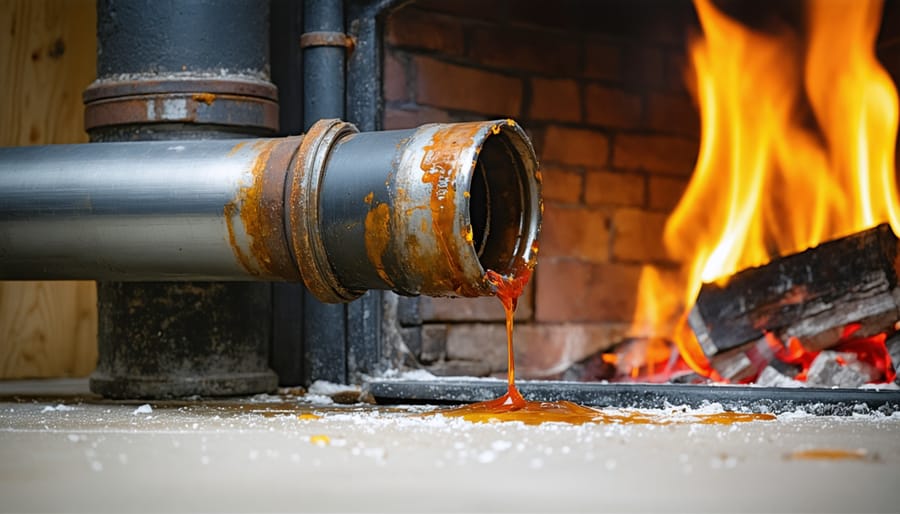
The Damper Decision: When and Where to Install
A damper is your secret weapon for controlling how your wood stove performs, acting like a throttle that regulates airflow through your 8-inch pipe system. The sweet spot for damper placement is typically 12 to 18 inches above your stove’s flue collar, where you can easily reach it but it’s positioned to effectively manage draft.
Think of your damper as a heat retention tool rather than just a draft control device. When you partially close it during the burn cycle, you’re slowing down the escape of warm air, giving heat more time to radiate into your living space instead of rushing straight up the chimney. This simple adjustment can significantly reduce fuel consumption while keeping your home cozy.
Here’s the key: never fully close your damper while a fire is burning. You want to find that balance where smoke exits efficiently without letting precious warmth escape too quickly. Start with your damper fully open when lighting your fire, then gradually adjust it as the fire establishes itself. Most homeowners find their ideal setting allows just enough draft to maintain a clean, steady burn while maximizing heat output, making your wood stove a truly efficient, eco-friendly heating solution.
Maintenance Strategies That Keep Your 8-Inch Pipe Working Efficiently
How Often Should You Clean Your 8-Inch Pipe?
Your cleaning schedule depends largely on how you use your wood stove and what you’re burning. If you’re heating your home daily during winter months, plan to inspect your 8-inch pipe monthly and clean it at least twice per season. Weekend users or those burning occasionally can typically get by with one thorough cleaning per year, ideally before the heating season begins.
The type of wood you burn makes a significant difference too. Hardwoods like oak and maple burn cleaner and produce less creosote buildup than softer woods like pine. If you’re burning softer, resinous woods or wood that isn’t properly seasoned, you’ll need to clean more frequently—potentially every four to six weeks during heavy use.
Watch for telltale signs that cleaning is overdue: reduced draft, smoke backing up into your room, a strong odor when the stove isn’t in use, or visible flaky deposits when you shine a flashlight up the pipe. These signals mean creosote has accumulated to dangerous levels, creating a fire hazard that demands immediate attention.
As an eco-friendly heating solution, your wood stove performs best when maintained properly. Regular cleaning not only keeps your home safe but also maximizes efficiency, meaning you’ll burn less wood while enjoying consistent, comfortable warmth throughout your living space.
Spotting Efficiency-Killing Problems Before They Worsen
Your 8-inch wood stove pipe works hard throughout the heating season, and small problems can snowball into major efficiency losses if left unchecked. Learning to spot these issues early protects your investment and keeps your home comfortably warm without burning through extra firewood.
Start by examining your pipe for rust or corrosion, particularly at joints and seams where moisture tends to accumulate. Even minor surface rust can eventually eat through the metal, creating dangerous gaps. Run your hand along accessible sections (when the stove is completely cold) to feel for rough patches or flaking metal that indicate deterioration.
Leaks often announce themselves through white or brown staining around pipe connections. You might also notice smoke smell in your home when the stove is running, or see wisps of smoke escaping from joints. These seemingly minor leaks force your system to work harder while allowing harmful gases to enter your living space.
Blockages develop gradually as creosote builds up inside the pipe, narrowing the passage for exhaust gases. Warning signs include smoke backing up into the room, difficulty getting fires started, or sluggish flames even with good wood. Your stove may also burn through wood faster than usual as it struggles against restricted airflow.
Check for physical damage too, like dents, loose sections, or separation at joints. Temperature changes cause pipes to expand and contract, which can loosen connections over time. Give accessible pipe sections a gentle wiggle to ensure everything remains snug and properly aligned, maintaining the efficient draft your heating system needs.
Simple Upgrades and Accessories for Better Heat Capture
Heat Reclaimers: Are They Worth It for 8-Inch Pipes?
Heat reclaimers can be a tempting addition to your 8-inch wood stove pipe, promising to capture escaping heat and redirect it back into your living space. But do they deliver on that promise? The short answer is yes, but with realistic expectations.
These devices work by wrapping around your stovepipe and using a series of tubes or fins to pull heat from exhaust gases. You can expect efficiency gains of around 10-20%, which translates to a warmer home and modest fuel savings. They’re particularly effective in rooms where the stovepipe runs through living spaces rather than immediately into a wall or ceiling.
Installation is straightforward for most homeowners, fitting directly onto your existing pipe. However, there’s an important trade-off to consider: heat reclaimers cool your flue gases, which can increase creosote buildup. This means more frequent cleaning becomes essential for safe operation.
Like heat-powered fans, heat reclaimers offer an eco-friendly way to maximize your wood stove’s performance without electricity. They’re most worthwhile if you have significant exposed pipe runs and are committed to regular maintenance. For casual users or those with minimal exposed piping, the modest gains might not justify the added cleaning requirements.
Using a Pipe Thermometer to Optimize Burn Efficiency
A pipe thermometer is your wood stove’s dashboard, giving you real-time feedback on how efficiently your system is running. By monitoring the temperature in your 8-inch stovepipe, you can find that perfect balance between maximizing heat output and preventing dangerous creosote buildup.
The ideal temperature range for most wood stoves falls between 250°F and 400°F, measured about 18 inches above the stove. Below 250°F, your fire isn’t burning hot enough, which means incomplete combustion and creosote accumulation. Above 500°F, you’re wasting heat up the chimney and risking an overfired stove that could damage components or even spark a chimney fire.
Installing a magnetic or probe-style thermometer is simple and inexpensive, yet it transforms how you manage your fire. You’ll quickly learn how different wood types, loading techniques, and air control settings affect your burn efficiency. This feedback helps you adjust in real time, ensuring you’re getting the most warmth from every log while keeping your system safe.
Think of it as fine-tuning your home’s eco-friendly heating system. When you consistently maintain proper temperatures, you’ll burn less wood, produce fewer emissions, and enjoy more consistent warmth throughout your living space.
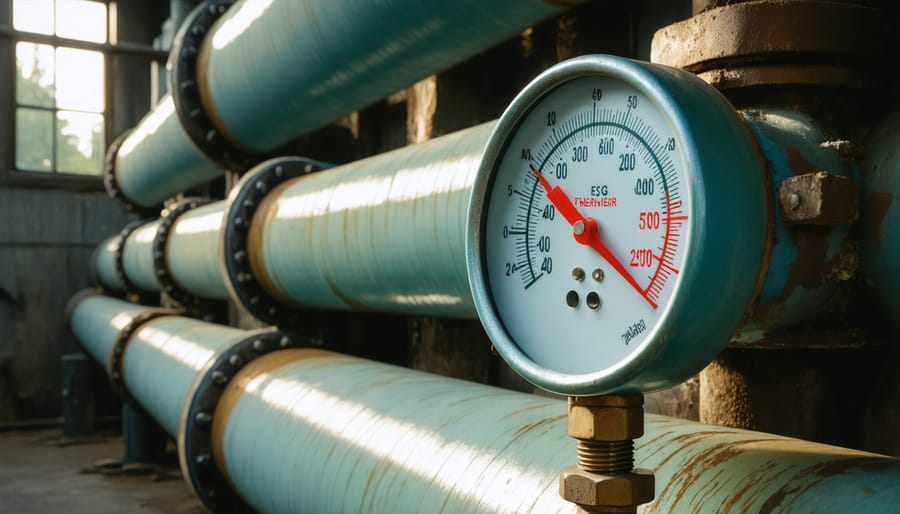
Taking the time to properly select, install, and maintain your 8-inch wood stove pipe isn’t just about following guidelines—it’s about transforming your home heating experience into something truly exceptional. When you get these fundamentals right, you’re not just burning wood; you’re creating a sustainable, efficient system that keeps your family cozy while treading lightly on the planet.
Think about where you are right now with your wood heating setup. Have you noticed uneven heating, excessive creosote buildup, or higher fuel consumption than you’d like? These are signs that your system might benefit from the strategies we’ve discussed. Whether it’s upgrading to double-wall pipe for better draft performance, ensuring proper clearances for safety, or simply committing to a regular maintenance schedule, each improvement compounds into meaningful results.
The beauty of optimizing your 8-inch wood stove pipe system is that the benefits extend far beyond your heating bills. You’re reducing smoke emissions, minimizing your carbon footprint, and embracing a lifestyle that values renewable energy and thoughtful resource management. There’s something deeply satisfying about knowing your home’s warmth comes from a well-tuned, eco-friendly system.
As you move forward, remember that wood heating done right offers an unmatched combination of comfort, sustainability, and self-reliance. Your commitment to proper pipe selection and maintenance means more evenings gathered around reliable warmth, fewer environmental concerns, and a heating system that performs beautifully season after season. That’s the true reward of taking wood stove efficiency seriously.
